Abstract
Possible mechanisms involved in the action of 4-nitropyridine 1-oxide (4NPO) on Escherichia coli K-12 pro+ cells in Penassay broth leading to the selective isolation of proA− and/or proB− mutants but not proC− mutant were studied. Reconstruction experiments between pro+ and pro− cells, together with experiments on the bactericidal action of 4NPO on pro+ and pro− cells, indicated that 4NPO is more toxic for pro+ and proC− cells than for proA− and proB− cells. These results, coupled with data indicating little mutagenicity of 4NPO on E. coli cells, led us to conclude that the selection of proA− and/or proB− cells that arose spontaneously in the pro+ culture is a possible mechanism for the action of 4NPO. Examination of 4NPO sensitivity of pro+ transductants derived from proA− and proB− cells with P1 vir phage and pro+ cells as donor and of pro+ spontaneous revertants derived from those pro− cells suggested that 4NPO-sensitive gene(s) should be on, or very close to, the proA and proB loci and that both products of proA and proB genes may be involved in the sensitivity of bacteria to 4NPO. The fact that the 4NPO-sensitive allele is dominant over the 4NPO-resistant allele further indicated the possible correlation between gene products of proA and proB and the 4NPO sensitivity of bacteria. Experiments on metabolic conversion of 4NPO with bacterial cells proved that the major metabolic pathway of the agent is reduction to (possibly via 4-nitroso-) 4-hydroxylamino- and 4-amino-pyridine 1-oxides, and then to 4-aminopyridine. Investigation of the effect of structural modification of 4NPO on the elective selection of Pro− mutants in Pro+ culture further suggested that the structural feature indispensable for the action of the agent is the hydroxyl-amino or its more oxidized state at the 4 position and the N-oxide moiety at the 1 position on the pyridine skeleton. Action of 4NPO in minimal medium was found to be bacteriostatic on pro+ cells but not on pro− cells, leading to the formation of long nonseptate multinucleate filament cells on pro+ cells. Possible biochemical mechanisms of the selective toxicity of 4NPO for pro+ and pro− cells are discussed.
Full text
PDF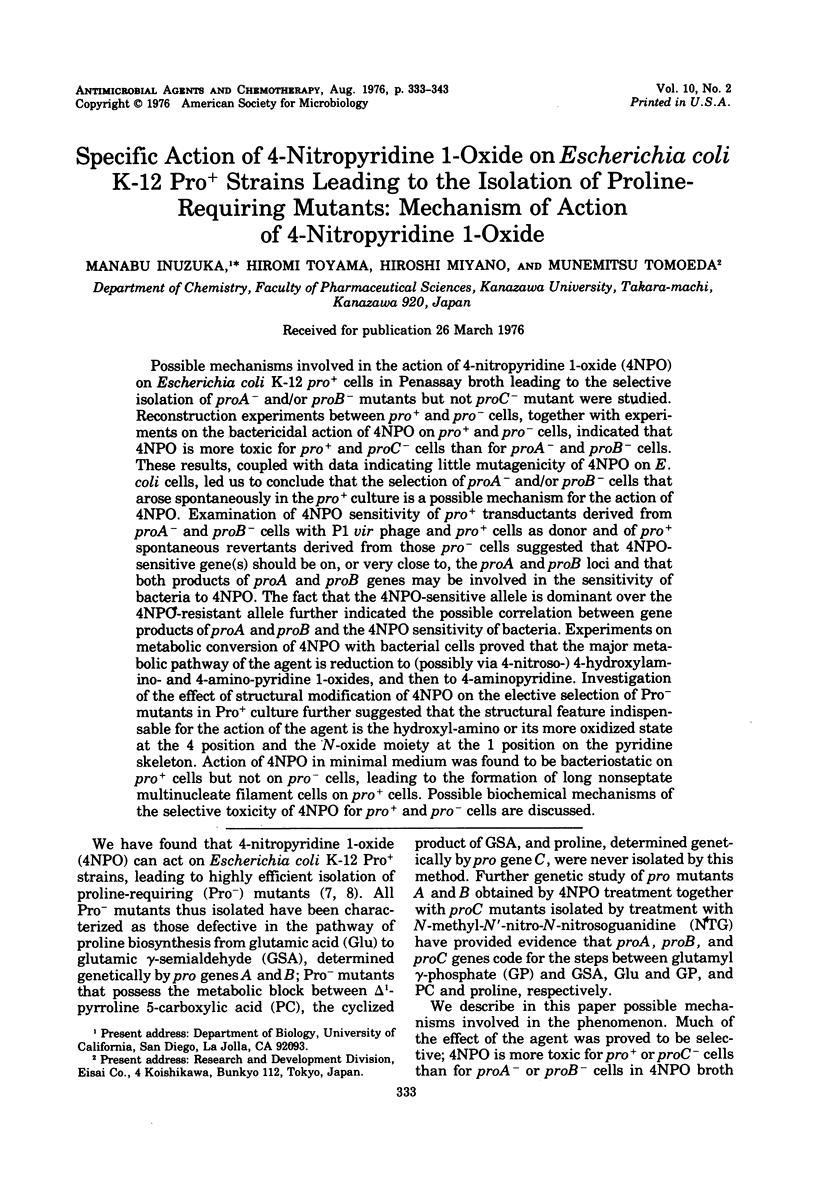
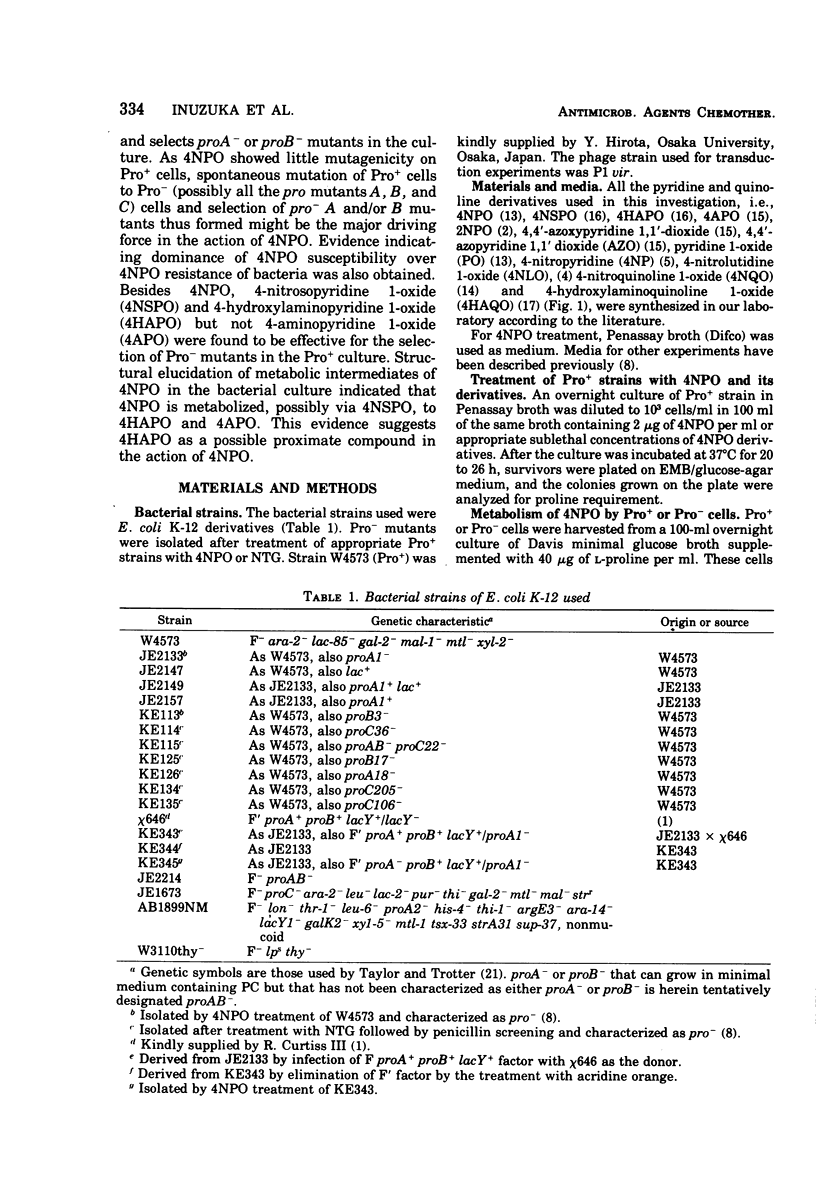
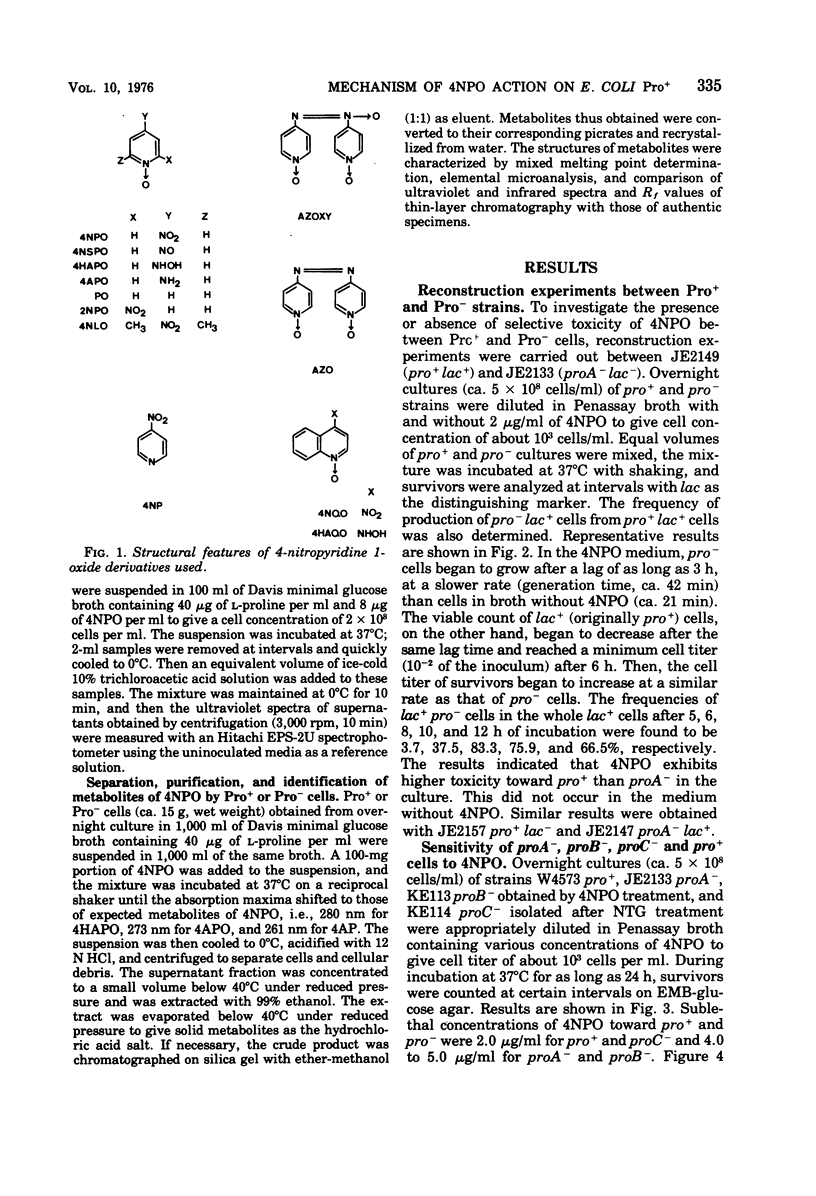
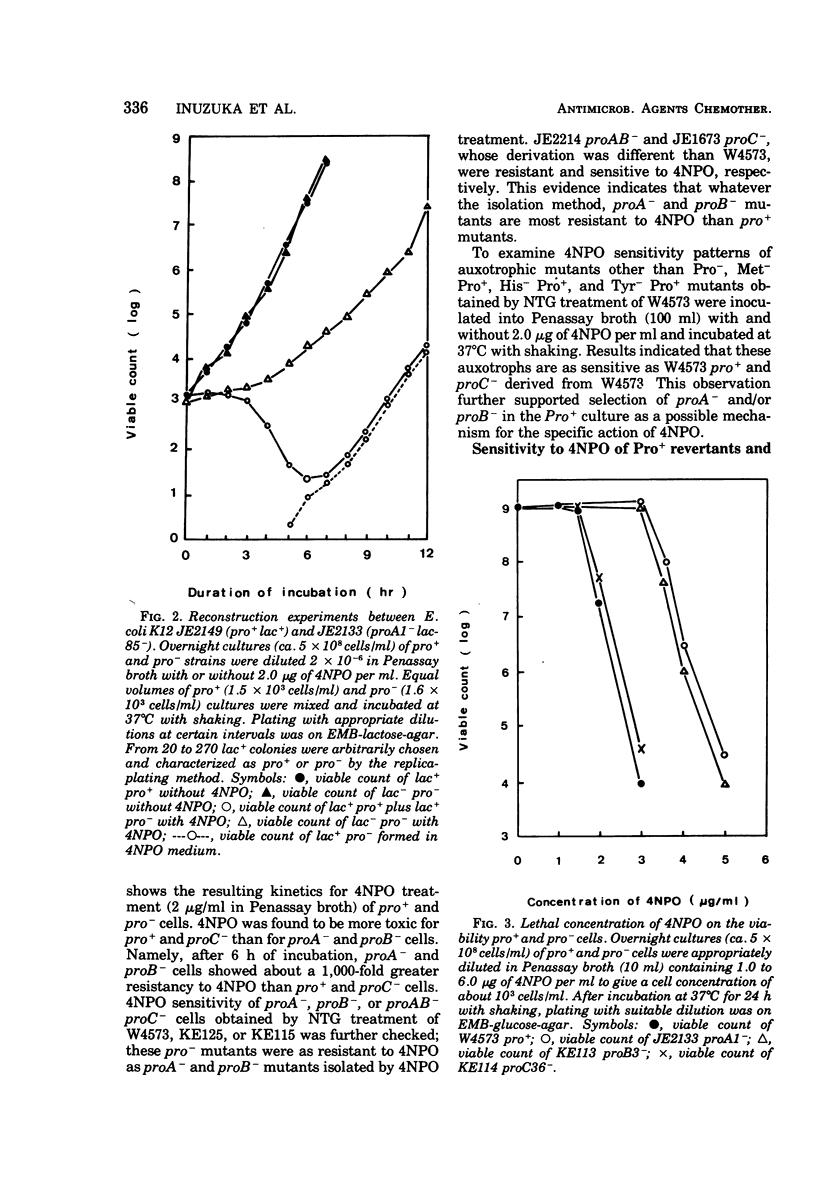
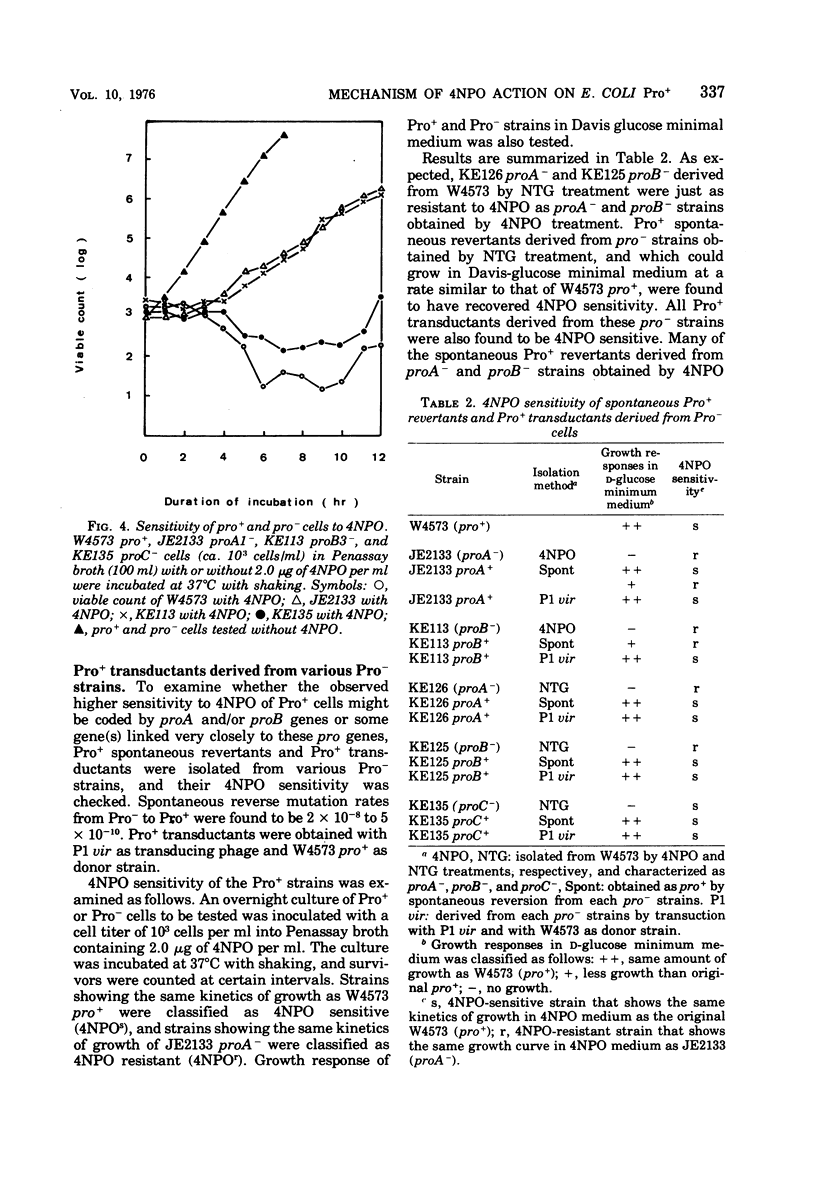
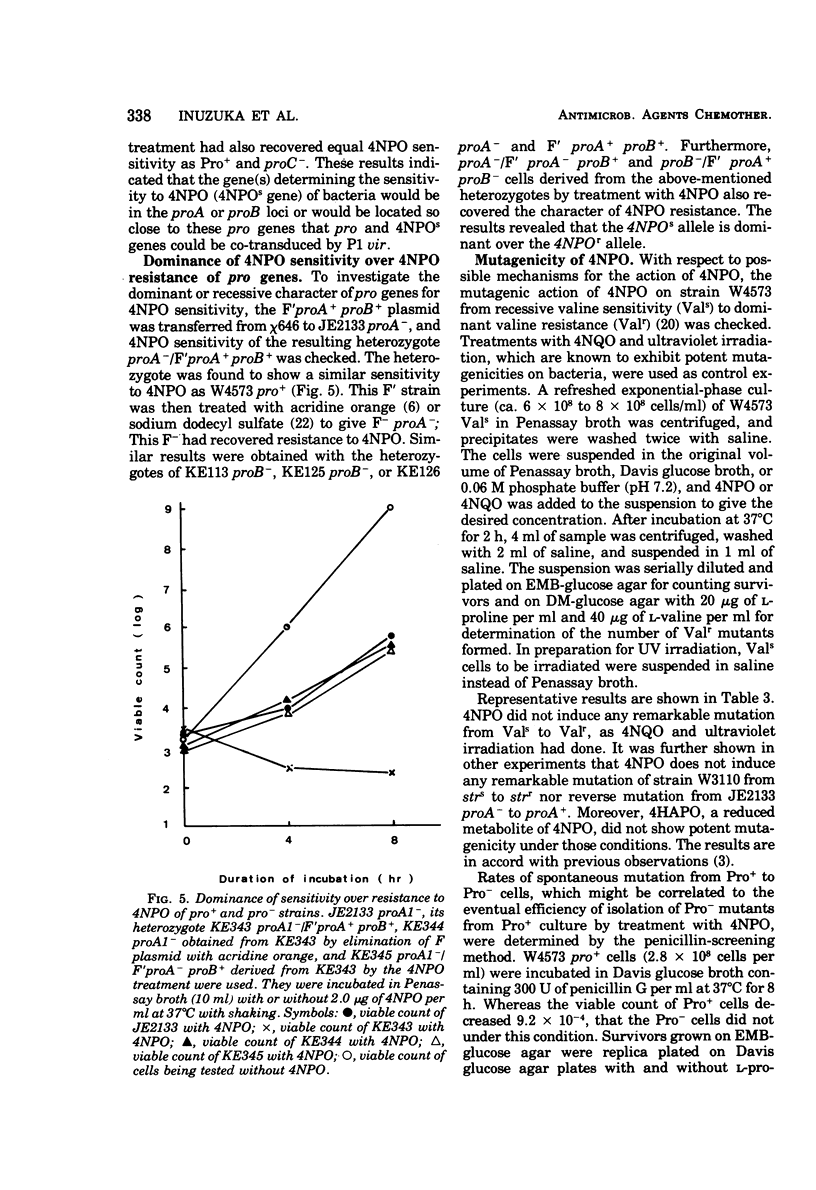
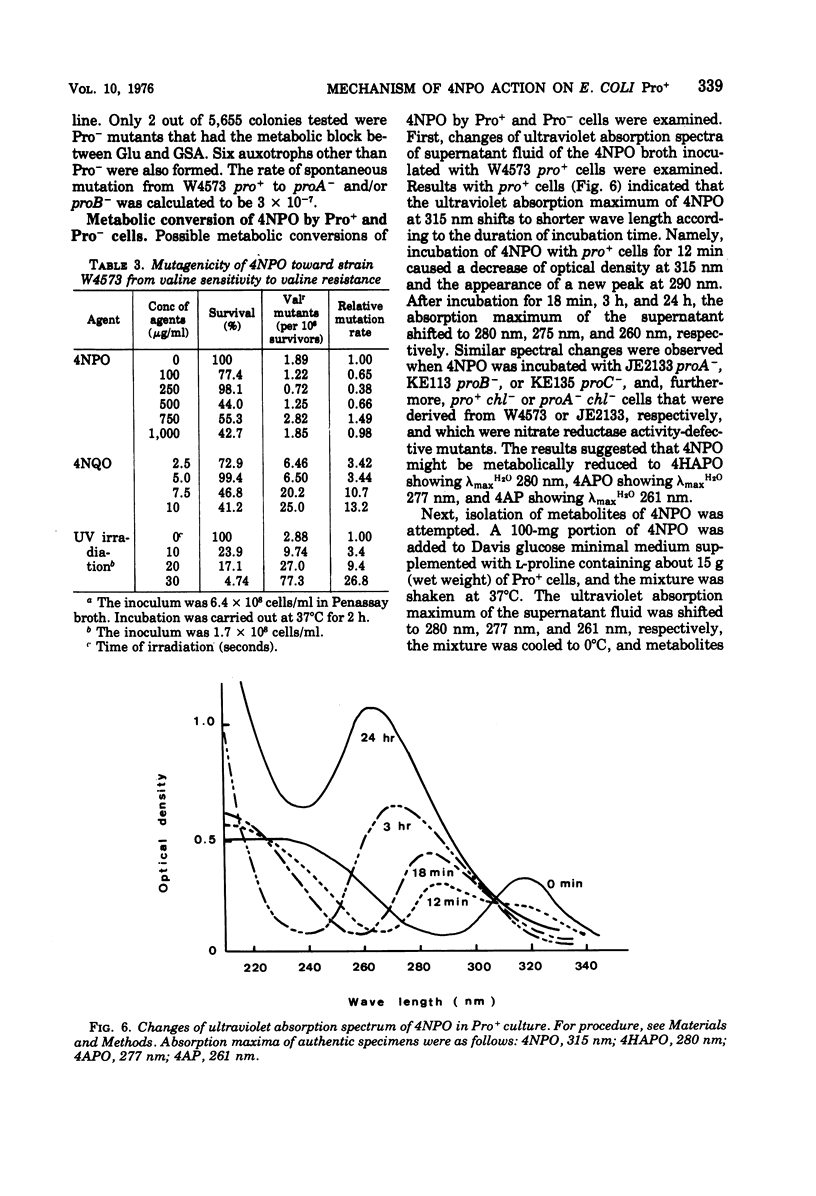
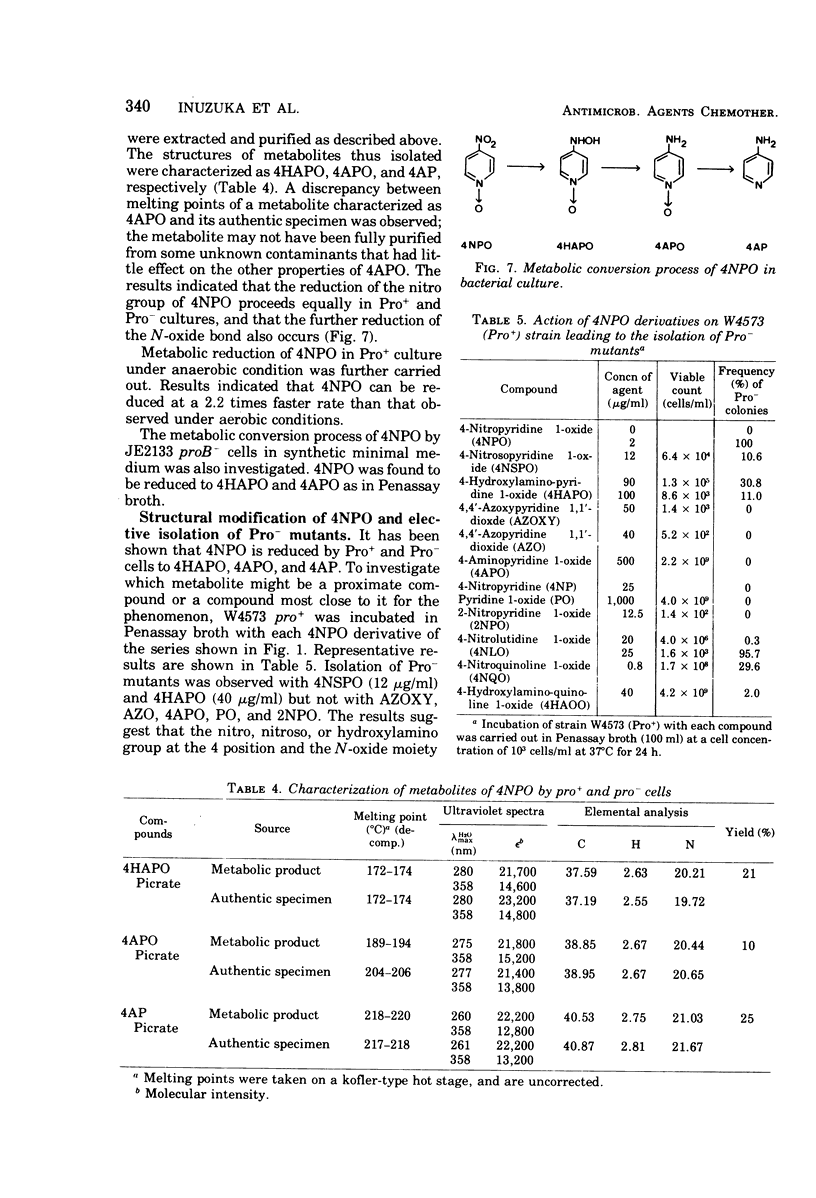
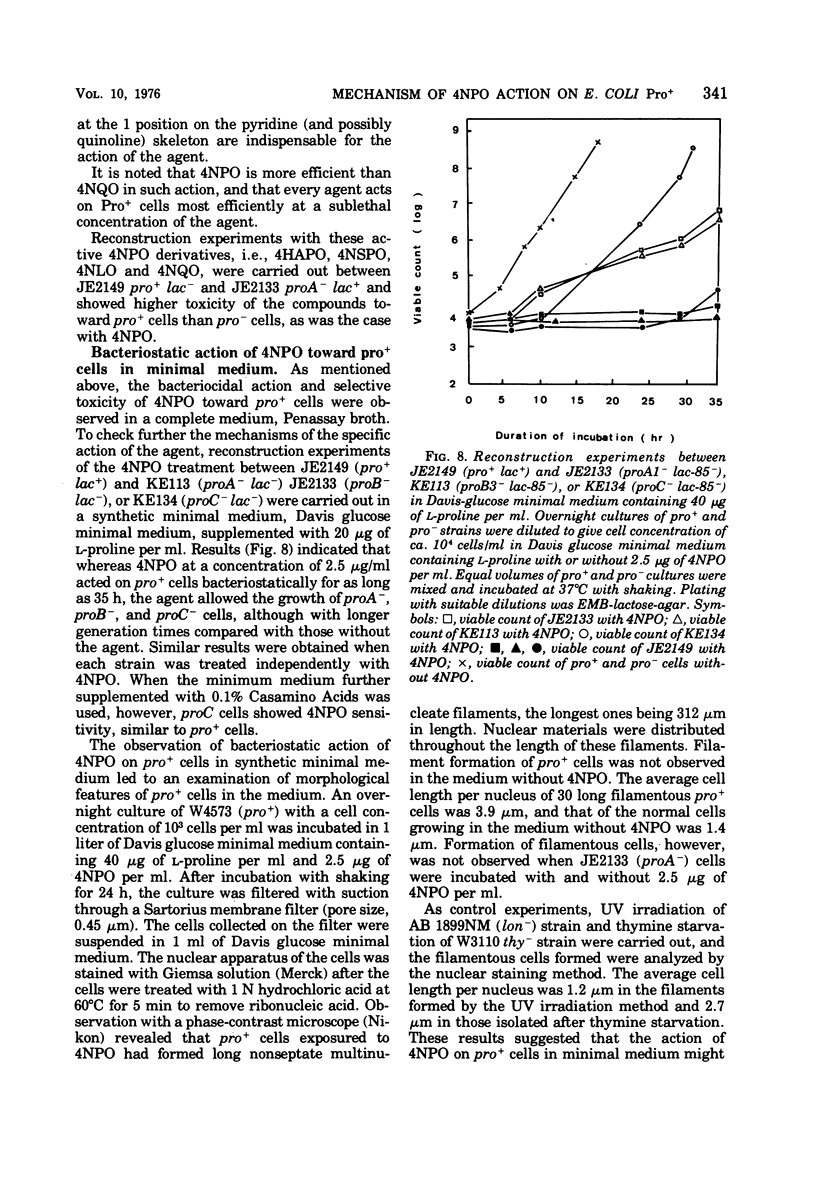
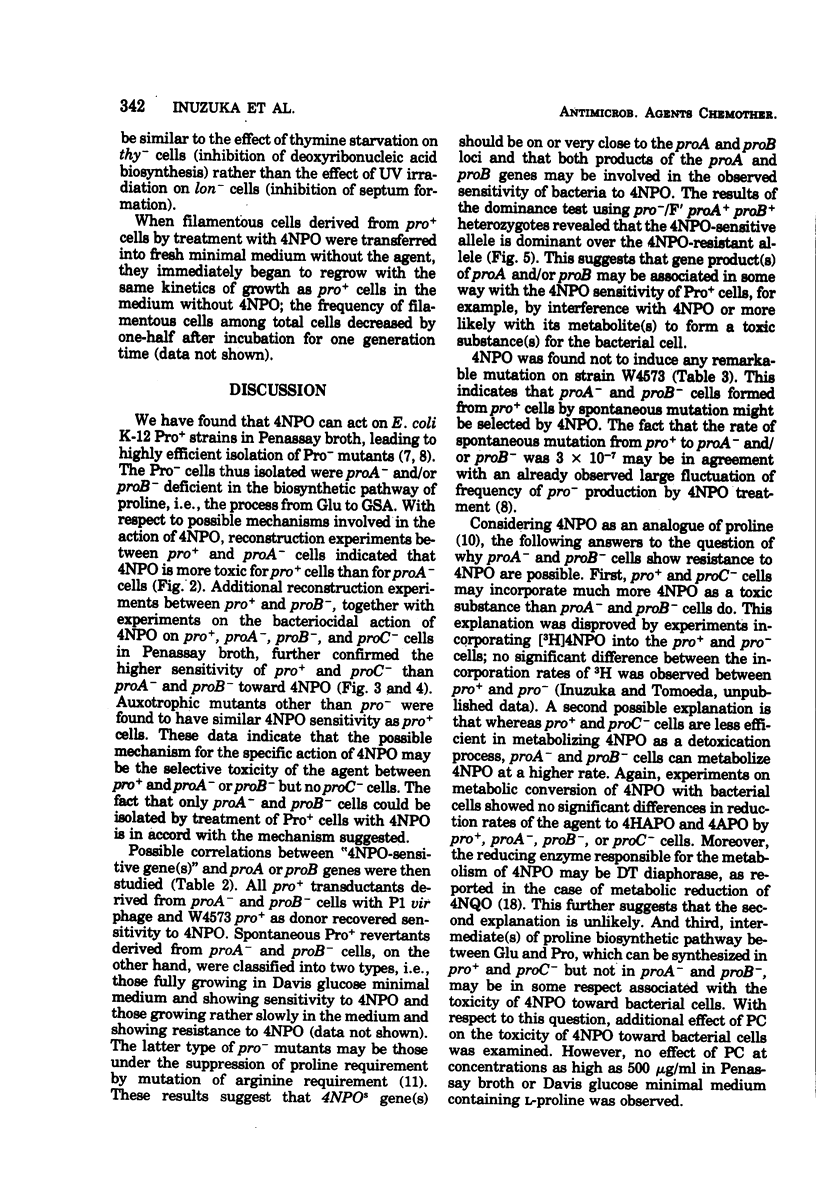
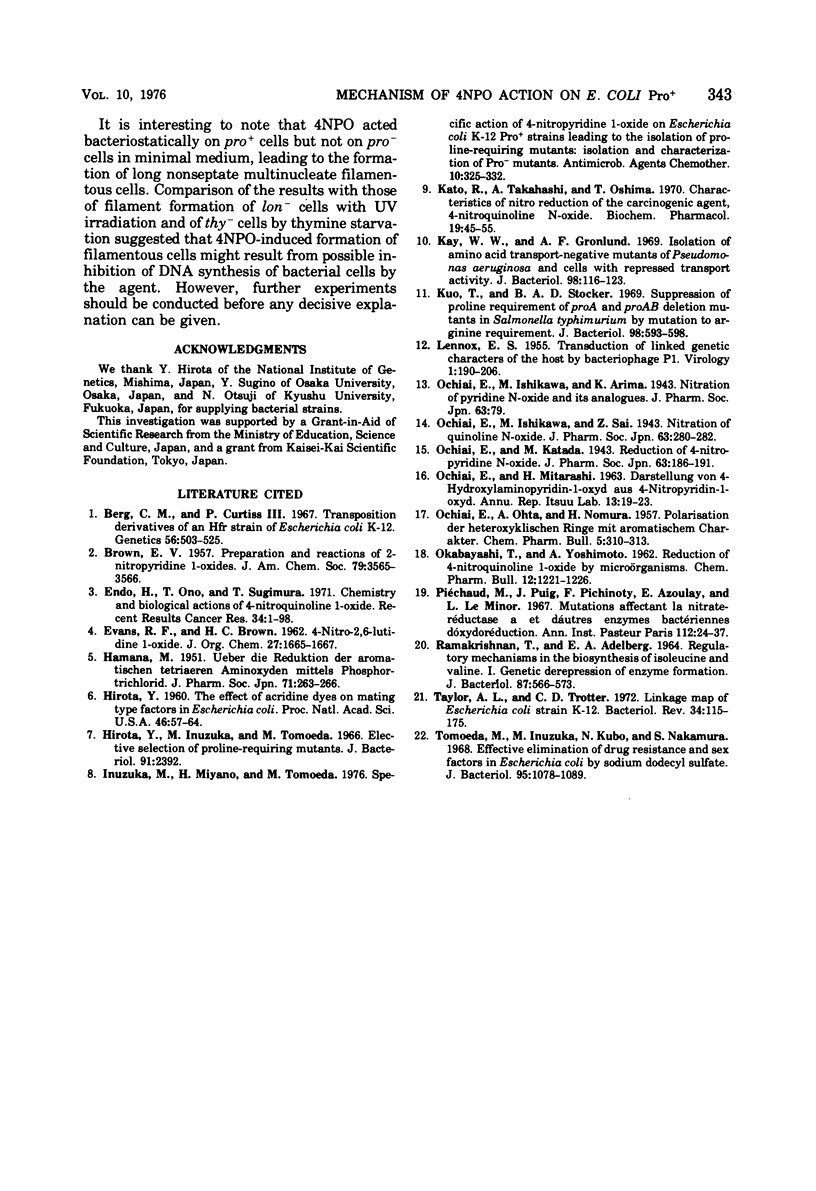
Selected References
These references are in PubMed. This may not be the complete list of references from this article.
- Berg C. M., Curtiss R., 3rd Transposition derivatives of an Hfr strain of Escherichia coli K-12. Genetics. 1967 Jul;56(3):503–525. doi: 10.1093/genetics/56.3.503. [DOI] [PMC free article] [PubMed] [Google Scholar]
- Hirota Y., Inuzuka M., Tomoeda M. Elective selection of proline-requiring mutants. J Bacteriol. 1966 Jun;91(6):2392–2392. doi: 10.1128/jb.91.6.2392-.1966. [DOI] [PMC free article] [PubMed] [Google Scholar]
- Hirota Y. THE EFFECT OF ACRIDINE DYES ON MATING TYPE FACTORS IN ESCHERICHIA COLI. Proc Natl Acad Sci U S A. 1960 Jan;46(1):57–64. doi: 10.1073/pnas.46.1.57. [DOI] [PMC free article] [PubMed] [Google Scholar]
- Inuzuka M., Miyano H., Tomoeda M. Specific action of 4-nitropyridine 1-oxide on Excherichia coli K-12 pro+ strains leading to the isolation of proline-requiring mutants: isolation and characterization of pro-mutants. Antimicrob Agents Chemother. 1976 Aug;10(2):325–332. doi: 10.1128/aac.10.2.325. [DOI] [PMC free article] [PubMed] [Google Scholar]
- Kato R., Takahashi A., Oshima T. Characteristics of nitro reduction of the carcinogenic agent, 4-nitroINOLONE N-oxide. Biochem Pharmacol. 1970 Jan;19(1):45–55. doi: 10.1016/0006-2952(70)90328-x. [DOI] [PubMed] [Google Scholar]
- Kay W. W., Gronlund A. F. Isolation of amino acid transport-negative mutants of Pseudomonas aeruginosa and cells with repressed transport activity. J Bacteriol. 1969 Apr;98(1):116–123. doi: 10.1128/jb.98.1.116-123.1969. [DOI] [PMC free article] [PubMed] [Google Scholar]
- Kuo T. T., Stocker B. A. Suppression of proline requirement of proA and proAB deletion mutants in Salmonella typhimurium by mutation to arginine requirement. J Bacteriol. 1969 May;98(2):593–598. doi: 10.1128/jb.98.2.593-598.1969. [DOI] [PMC free article] [PubMed] [Google Scholar]
- LENNOX E. S. Transduction of linked genetic characters of the host by bacteriophage P1. Virology. 1955 Jul;1(2):190–206. doi: 10.1016/0042-6822(55)90016-7. [DOI] [PubMed] [Google Scholar]
- OCHIAI E., OHTA A., NOMURA H. Polarisation der heterozyklischen Ringe mit aromatischem Charakter. CXVIII. Uber das 4-Hydroxyaminochinolin-N-oxyd. Pharm Bull. 1957 Aug;5(4):310–313. doi: 10.1248/cpb1953.5.310. [DOI] [PubMed] [Google Scholar]
- OKABAYASHI T., YOSHIMOTO A. Reduction of 4-nitroquinoline l-oxide by microorganisms. Chem Pharm Bull (Tokyo) 1962 Dec;10:1221–1226. doi: 10.1248/cpb.10.1221. [DOI] [PubMed] [Google Scholar]
- Piéchaud M., Puig J., Pichinoty F., Azoulay E., Le Minor L. Mutations affectant la nitrate-réductase A et d'autres enzymes bactériennes d'oxydoréduction. Ann Inst Pasteur (Paris) 1967 Jan;112(1):24–37. [PubMed] [Google Scholar]
- RAMAKRISHNAN T., ADELBERG E. A. REGULATORY MECHANISMS IN THE BIOSYNTHESIS OF ISOLEUCINE AND VALINE. I. GENETIC DEREPRESSION OF ENZYME FORMATION. J Bacteriol. 1964 Mar;87:566–573. doi: 10.1128/jb.87.3.566-573.1964. [DOI] [PMC free article] [PubMed] [Google Scholar]
- Tomoeda M., Inuzuka M., Kubo N., Nakamura S. Effective elimination of drug resistance and sex factors in Escherichia coli by sodium dodecyl sulfate. J Bacteriol. 1968 Mar;95(3):1078–1089. doi: 10.1128/jb.95.3.1078-1089.1968. [DOI] [PMC free article] [PubMed] [Google Scholar]


